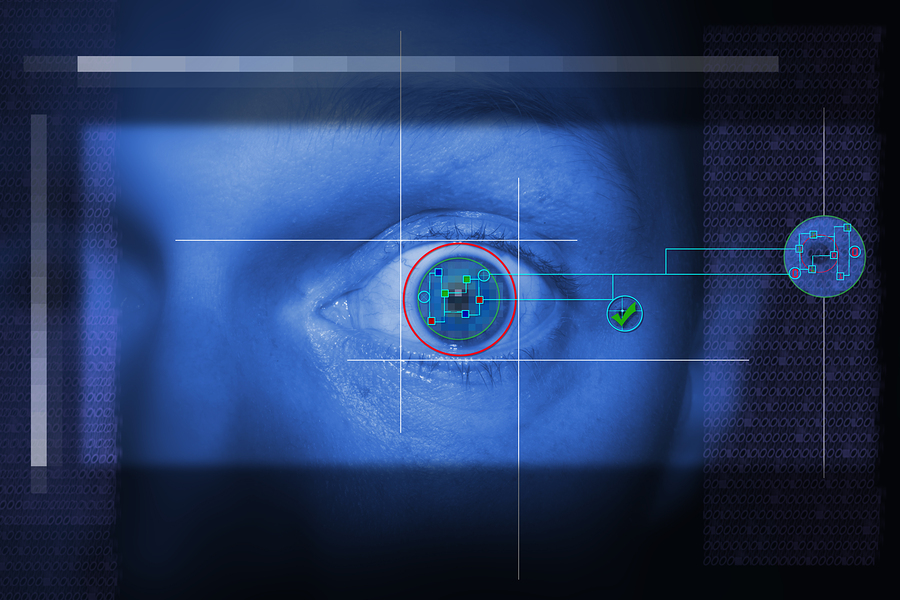Biometrics has evolved into a multi-use tool for corporations and government organizations.
While the surface is just being scratched as far as the full potential of biometrics, a basic knowledge of the science involves an understanding of the two types of biometric systems: physiological biometrics, sometimes called Physiometrics, and behavioral biometrics, often known as Behaviometrics.
Physiological biometric systems compile and analyze physical characteristics associated with a subject or group of subjects. Examples of physiological biometric applications include retinal scans and facial recognition software. Behavioral biometric systems track subjects’ patterns and habits, analyzing and identifying individuals by gait, this includes typing patterns, as well as by voice. When a behavioral biometric system is put into place, there is first an “enrollment period,” during which time the system analyzes the subject for identifying patterns; the system will then analyze that subject on the adherence of those patterns.
Recently, however, biometric systems have been developed with multimodal adaptivity. This advancement negates the necessity of retraining the system when there is a change in the subject’s environment that would alter the integrity of the pattern established during enrollment – for example, a replacement keyboard in regard to the above-mentioned typing pattern example. This lessens the necessity of enrollment periods in general. The practical benefit here is that biometric systems are becoming highly efficient and user friendly, making them available to anyone with the necessary infrastructure.
Often, biometrics is used for security purposes. Biometrics has surpassed fingerprints, passwords, and keycards in reliability, increasing resistance to fraudulent terminal logins. As has been dramatized in James Bond movies since the 1960s, biometrics can control points of entry and access and can track individuals’ movements throughout the premises. These movements can be verified on the spot via retinal scans, voice reads, and even pressure point analysis when punching in an entry code. The days of sneaking into restricted areas with someone else’s keycard are over, a development which is crucial to the security operations of military and government installations as well as private sector financial and medical institutions.
Further, the use of biometrics has made its way into both the public and private sectors in terms of cybersecurity. Many desktops, laptops, and tablets now come standard with facial recognition software, such as VeriFace, as a login protocol. The benefits here are both proprietary and security related. For example, these biometric-based protocols keep internal data secure by guarding personal information pertaining to both employees and clients, such as banking information, from theft.
Companies like Zerco Systems are creating stand-alone biometric systems that don’t require linking to a central computer to verify information. For example, Zerco’s ID cards contain fingerprints, facial recognition, signatures, voice prints, iris scans and other biometrics. This could have significant impact on the ability of employees to safely log in and telecommute over a secure network, on the integrity of public networks that require age verification, and even on simple website membership confirmation.
Biometric gait analysis, which has been employed in gaming and movie production for animating human actors, can offer reliable identity verification past the login stage. Just as an actress’s movements and mannerisms were read and translated to the movie and gaming screens when creating Laura Croft, a biometric system will create a composite of an individual user based on his movements and mannerisms. If the movements and mannerisms of a user at that system terminal do not match the composite, the system will be alerted to the deviation and can potentially shut down the system. This way, unauthorized users can be prohibited from taking over a terminal post-login.
This same biometric system can also track individual productivity – both as a monitor and as a method of analyzing optimal team placement and workflow management. Biometric systems can easily identify whether or not an individual would be better suited for a different position by identifying if he is able to more quickly complete a particular task than the other members of his workgroup or by analyzing his ease and comfort level when operating a specific system or application. The employee can potentially be refocused on the task that suits him best; whole workgroups can then be streamlined for optimum productivity by matching up each member with his strengths. In pursuit of this end, companies like BioMetrics are using state-of-the-art ergonomic and neuropsychological analyses, brainwave biofeedback techniques, and organizational assessment techniques for studies such as stress tests, which can ensure optimal productivity by indicating if stress is a factor in employee performance.
Karen Goor is a customer interaction specialist at NICE Systems, a company that specializes in workforce management.
Sources:
http://en.wikipedia.org/wiki/Biometrics#History_of_Biometrics
http://www.biofeedback.net/corporate/
http://findbiometrics.com/zerco-offers-corporate-america-biometric-worker-id-solution/




